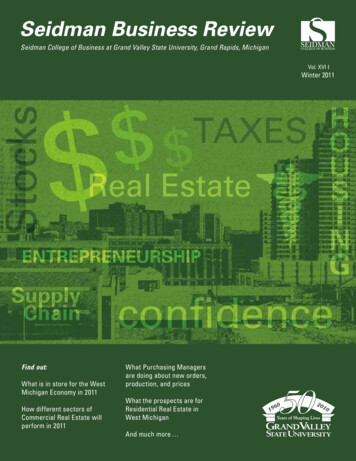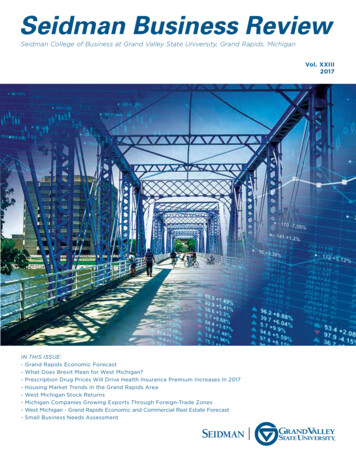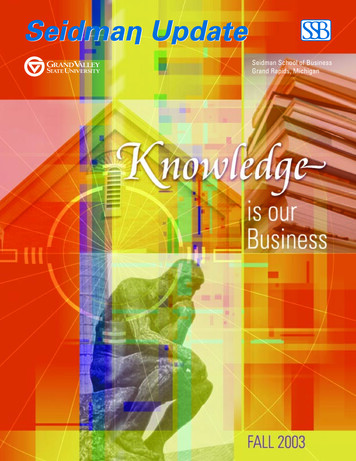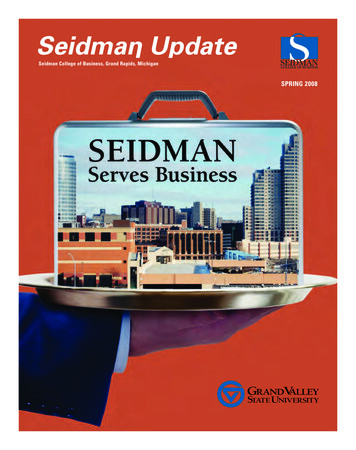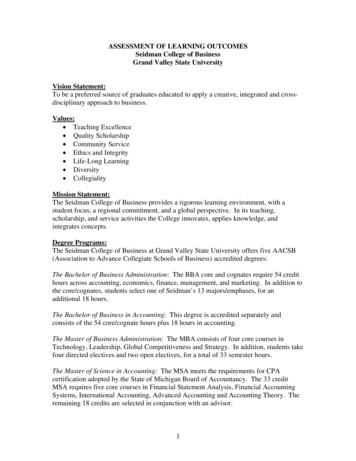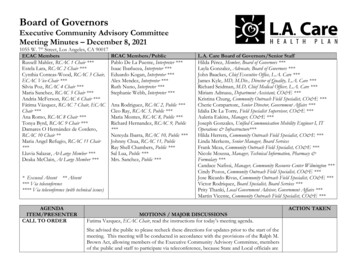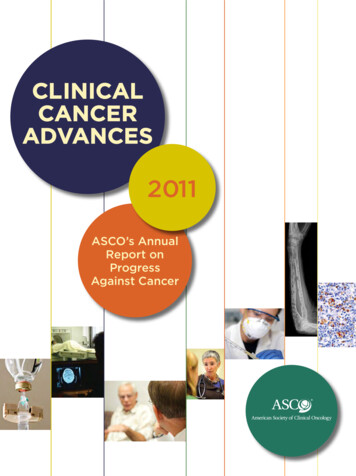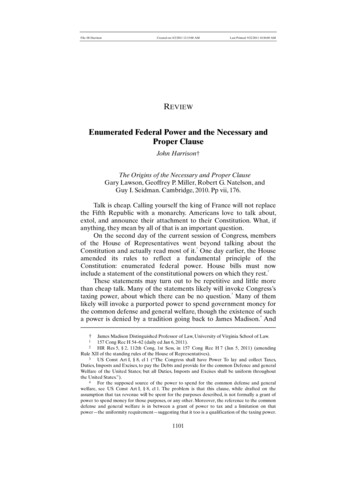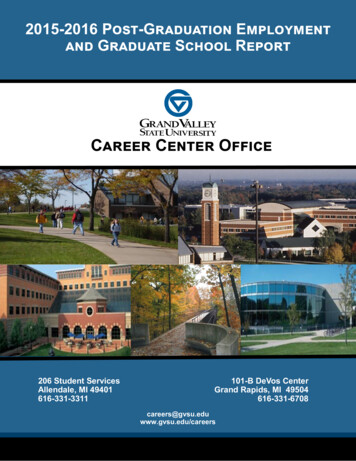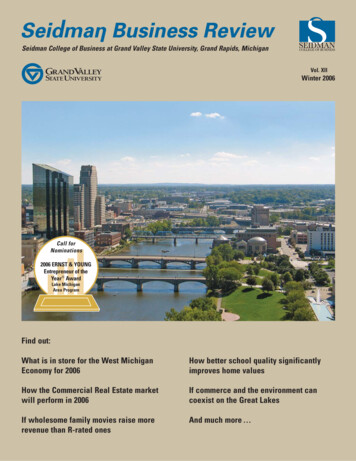
Transcription
Seidman College of Business at Grand Valley State University, Grand Rapids, MichiganVol. XIIWinter 2006Call forNominations2006 ERNST & YOUNGEntrepreneur of theYear AwardLake MichiganArea ProgramFind out:What is in store for the West MichiganEconomy for 2006How better school quality significantlyimproves home valuesHow the Commercial Real Estate marketwill perform in 2006If commerce and the environment cancoexist on the Great LakesIf wholesome family movies raise morerevenue than R-rated onesAnd much more
SEIDMANBUSINESS SERVICES outreach to the Greater Grand RapidsBusiness CommunityMichigan Small Business & TechnologyDevelopment Center616.331.7370 www.www.misbtdc.org No-cost one-to-one business counsel Low-cost small business seminars Market research Referrals to business development resources Small business advocacyInformation Services616.331.7370 www.gvbizinfo.com Demographic profiles of GR and Lakeshore Customized research services Market data/business related information Online commercial databasesFamily Owned Business Institute616.331.7200 www.fobi.gvsu.edu Research Family business resource center Family business courseworkEthics Center616.331.7449 Business ethics roundtables Seminars and workshops Research Ethics courseworkOther Partners in Outreach —Educational Opportunities Offered by theSeidman College of BusinessINTERNATIONAL ASSISTANCE:Van Andel Global Trade Center616.331.6811 www.vagtradecenter.org Conferences, seminars, and workshops Custom/Contract training Certificate programs Electronic resource room Import/Export counselingU.S. Dept. of Commerce Export Assistance Center616.458.3564 Export counseling Trade finance assistance Conferences, seminars, and workshops Market research Export market representationPartnerships Serving the Business CommunityMichigan Works! West Central616.331-7370 (to schedule an appointment)Small business counsel in area of procurement/government contractingKent Area MicroBusiness Loan Services (KAMLS)616.771.6880233 E. Fulton, Suite 101Loans between 1,000 and 35,000 for Kent Countystartup and young “pre-bankable” businessesSBA Business Information Center616.771.6880233 E. Fulton, Suite 101A one-stop shop for entrepreneurs to access resourcesto build their business or launch their companyBachelor of Business Administration (BBA) Accounting Business Economics —Emphasis in Real Estate Finance International Business Management —Emphases in general, human resources,operations, organizational information systems Marketin — Emphases in Distribution and Logistics andProfessional SalesBachelor of Arts (BA) or Bachelor of Science (BS) in EconomicsMaster of Business Administration (MBA) General Accounting emphasis Taxation emphasis Management of Innovation and Technology emphasisMaster of Science in Taxation (MST)Master of Science in Accounting (MSA)Certificate Programs E-Commerce TaxationNon-Credit Certificate Programs Certified Financial Planning (CFP) NxLevel Entrepreneurial Program
From the Dean Welcome to another edition of the Seidman BusinessReview (the “Review”). As the new global economypresents new challenges to all West Michigan’s businesses,the Seidman College of Business continues to providecutting-edge, relevant, and real-world commentary focusedon sharing existing and emerging business knowledge,legislation, and innovations, in ways that are relevant andcompelling for West Michigan businesses and other publicand private organizations.Moreover, for this region to continue to thrive in the faceof increased national and international competition, it mustembrace and utilize fully the breadth and depth of its manyresources. Grand Valley State University and the SeidmanCollege of Business are especially proud to provide to thiscommunity significant resources of intellectual, cultural,and social capital, especially in light of the history of theUniversity, and its founding by a group of business leaders.During its brief history Grand Valley has fulfilled very wellits promise to the West Michigan community in the bestsense of the expectations of those founders. The Reviewcontinues the fulfillment of that promise.As usual, this edition begins with West Michiganeconomic and commercial real estate forecasts for 2006and a performance review of West Michigan’s regionalstocks. It also includes articles addressing a number ofother very timely topics — from economics literacy, tohealthcare savings accounts, costs and benefits of oceanvessel shipping in the Great Lakes, impending free tradeagreement with Thailand, the impact of quality schools onhousing values, profitability of family rated movies, andreligion in the workplace.I trust you will find this edition of the Seidman BusinessReview quite informative, even provocative. Seidman’sfaculty experts excel at both teaching and applicationsbased research and implementation. I direct your attentionto our “Panel of Experts,” on the last page of this issue.Perhaps, you can utilize Seidman’s faculty expertise toimprove your operations and facilitate your business andmanagement initiatives.— H. James WilliamsDean, Seidman College of BusinessSeidman Business Review is an annual publication of Grand ValleyState University’s Seidman College of Business, Grand Rapids, Michigan.e-mail: gvbizinfo@gvsu.eduEditor:Dr. Hari Singh, Chair, Economics DepartmentCopy editors:Vonnie HerreraClaudia BajemaDesign and production:Ruth Oldenburg, Rainstick StudioSeidman Business Review Winter 2006 Contents4 Grand Rapids Economic Forecast 2006Hari Singh, Ph.D., and Nancy Boese, M.B.A.The West Michigan economy has been in a process of consolidation and modestgrowth. How is the business confidence for 2006? What are the projections foremployment and sales for 2006? Find out what Grand Rapids area executives think.7 Commercial Real Estate Outlook for 2006Matt Williams, CCIM, Vice President, Grubb & Ellis ParamountThe commercial real estate market in greater Grand Rapids faces manychallenges and opportunities. The retail, office, and industrial markets are indifferent phases of the market cycle. Find out which sectors of the commercialreal estate industry are poised for growth.10 West Michigan Stock ReturnsGregg Dimkoff, Ph.D.The national stock market had a volatile and relatively flat year in 2005. In most recentyears, regional stocks have outperformed major national market indices in tougheconomic times. Did the regional stocks outperform major market indices in 2005?12 How School Quality Impacts Housing Values: Some Regional EvidenceJohn Reifel, Ph.D., and Paul Thorsnes, Ph.D.The authors demonstrate that comparable homes in better school districts arenormally priced higher; i.e., there is a significant market premium for school quality.Find out how paying higher taxes for improving schools may have an added benefit ofincreasing the value of your home.15 Profitability Study of MPAA Rated MoviesSridhar Sundaram, D.B.A., and Dick RolfeConventional wisdom in entertainment is that sex and violence increase box officerevenue. Is this really the case? Could wholesome family entertainment bringin more revenue?18 The Cost-Benefits of Ocean Vessel Shipping in the Great Lakes:Value to Industry vs. Environmental DamageJohn C. Taylor, Ph.D., James L. Roach, M.P.A., and Zornitsa Boshnakova, M.B.A., M.S.T.Ocean ships entering the Great Lakes generate transportation cost savings;however, these ships inevitably introduce invasive species that are a majorenvironmental hazard. In this surprising article, the authors demonstrate that thiscontroversial trade-off between commerce and environment is actually quitelopsided. Discover what we should do to manage the trade-off.21 Religion in the Workplace: New Perspectives and LawsMarie McKendall, Ph.D.In spite of our constitutional guidelines, the operational aspects of the separationbetween state and religion have always been controversial. The author analyzesproposed legislation that may have far reaching consequences for health careproviders and consumers.23 Health Savings Accounts: A New Approach to Control Rising Health Insurance PremiumsJeff S. Rubleski, M.B.A., Regional Sales Manager, Blue Cross Blue Shield of MichiganRising health care costs are not only a burden on individuals; they are alsobecoming a major competitive issue for corporations. Can recent legislation thathas introduced Health Savings Accounts (HSAs) control the spiraling costs to someextent? Find out how HSAs work and what their potential impact would be.26 Free Trade with Thailand — A New Threat for Michigan?Gerry Simons, Ph.D.On the surface it may seem that a Free Trade Agreement (FTA) between theUnited States and Thailand may not have a major impact on Michigan; however,there is a reason why Thailand is sometimes called “The Detroit of Asia.” Find outthe pros and cons of an FTA with Thailand.28 How Economically Literate are you?Amber Brown, Instructor, and John Nader, Instructor, Seidman College of BusinessGranted, it is not the most exciting subject, but economics enters into our daily life inmore ways than you can imagine. Some basic knowledge in economics can lead tobetter decision-making and improve your understanding of policy trade-offs. Ready totake the plunge?
Grand Rapids Economic Forecast 2006Hari Singh, Ph.D., and Nancy Boese, M.B.A.1Seidman College of Business Business Confidence has suffered a marginal decline and is expected to be flat for 2006 Employment growth is expected to be very modest, at best 0.5% for 2006 Overall sales are expected to grow at a rate comparable to last year, around 3% for 2006 Exports continue to be a bright spot; expected growth is 5% for 2006IntroductionOur latest survey forecast for the greater Grand Rapids economy(Kent, Ottawa, Muskegon, and Allegan Counties) was conductedin November 2005. A survey was mailed to the CEOs of 675organizations based on a representative sample. We tried toensure that the sample represented different sectors of theregional economy and the geographical diversity of the region.Eventually, 151 organizations responded. The results of thesurvey need to be interpreted with caution because of the smallsample size.A brief methodological note is in order. Although we discuss thesurvey results in terms of averages, the data are also presented ina histogram format to show the entire distribution of responses.The employment, sales, and export numbers are more volatileas raw averages (when calculated without adjusting for outliers ;that is, responses beyond one standarddeviation). Since the average of a smallsample is overtly influenced by extremenumbers, it is advisable to examine90both the raw averages and the meanvalues generated without the outliers.85The histograms, however, depict all theobservations. Since individual responsesvary significantly, the outliers in the data80should be interpreted with caution.Confidence IndexA primary goal of our survey is tohistorically track the overall businessconfidence of the Grand Rapids metropolitan area by a confidence index.Recall that this confidence index isscaled from zero % (no confidence atall) to one hundred % (complete confidence). The current results need to beinterpreted in a larger historical context.During our surveys of the region for thelast ten years, when the economy hasbeen growing steadily, the confidenceindex has continued to depict a high level of confidence, generally above 80% for the private sector.In the previous survey, the Confidence Index had risen modestlyto 69.6% at the end of 2004, amid economic evidence that theeconomy was growing slowly. The results this year indicate thatbusiness confidence of the private sector is relatively lower at65.3%. In past years, respondents have typically expected at leasta marginal improvement in confidence for the following year.This year their expectations for 2006 are virtually flat at 65.1%.We continue to base our analysis on the forecasts made by theprivate sector. The government and nonprofit sector is slightlymore optimistic this year (compared to the private sector) buttheir projection for 2006 is also flat. To some extent pragmaticoptimism has been replaced by the notion that things are notlikely to improve for awhile. In 2005, expectations of higher75706560Nov 1995Nov 1996Nov 1997Nov 1998Dec 1999Gov’t/Non-ProfitDec 2000Dec 2001Dec 2002Dec 2003(MI-SBTDC). We were aided by invaluable research support from Maria Ivantchenkova and other graduate research assistants at MI-SBTDC.Seidman Business Review Winter 2006Dec 2005All Sectors (excluding Gov't /Non-Profit)1 Hari Singh is Chair of the Economics Department. Nancy Boese is the Regional Director of the Michigan Small Business & Technology Development Center4Dec 2004Proj. 2006
interest rates, rising energy prices, the uncertainty due to the waron terrorism, and weak job growth prospects due to restructuring have further depressed expectations.EmploymentAmid well-publicized layoffs by major corporations in the WestMichigan area, the regional labor market has been repairing at aslow pace. Figure 2 indicates projected employment growth for2006. Overall, the growth in employment for 2006 is projectedat 0.76% with outliers and at 0.50% without outliers.Consider this expectation in the context of what we know aboutthe regional and national economy at this time. Traditionally, theregional and national economies have followed similar trendsin terms of the business cycle. However, this year the actualeconomic situation in Michigan is relatively worse comparedto the national economy. West Michigan has traditionallyrelied more on the manufacturing sector. The manufacturingsector continues to decline as more consolidation in theOur survey indicates that fewer respondents (64%) are likelyto hire new workers in 2006 compared to last year when thecorresponding number was 70%. Most respondents who intendto hire expect to employ permanent workers (76%) as opposedto temporary workers (24%). However, given that new jobapplicants will enter the labor market, net job opportunities willbe scarce.SalesSales projections made by respondents for last year were3.2%. Sales over the holiday season have held up quite well.The projected average sales growth for 2006 is 3.3% withoutoutliers and 2.6% with outliers (Figure 3). In times of robusteconomic growth, sales have grown at an annual rate of 5%.The expectations of our respondents indicate that it may takesome time before this higher-trend growth rate is achieved.Note that our sales numbers are for the nominal sales of allgoods/services produced in the West Michigan economy.Export growthOnly about a quarter of respondents in the privatesector export their output. The expected growth inexports has generally averaged higher than 5% inthe late 1990s. Last year, exports were projectedto grow at 4.4% without outliers and at 6.3% withoutliers. In 2006, exports are expected to growat 4.7% without outliers and 6.9% with outliers(Figure 4). Given the volatility in exchange ratesand uncertain prospects for worldwide growth, it isnot surprising that expectations for growth in exportsare volatile. The adjusted average growth is probablymore reliable. Overall, export growth projectionsare similar to last year’s expectations. Compared todomestic sales, export growth is still a bright spotfor the regional economy. Since the expectedgrowth of exports is based on a much smallersample, it should be viewed with caution.120100806040200Less than 0%From 0% to 1%From 1.01% to 2%From 2.01 to 3%workforce takes place, particularly in auto and autorelated industries. American auto manufacturers are losingmarket share and are saddled with high legacy costs. “TheMichigan Economic Outlook for 2006 – 07” by Universityof Michigan economists George Fulton and John Crarypredicts unemployment in the state to rise to 7.6% withina year, with manufacturing taking the major brunt of theadjustment process. Although the west side of the state willhave relatively less negative impact compared to the eastside, consolidation and job losses in manufacturing will stillcontinue in West Michigan; however, more jobs will continueto be created in the services sector.More than 3%Figure 35045403530252015105Employment growth in West Michigan during 2005 has beenapproximately one half of one %. The labor market in WestMichigan has been showing very modest growth in 2005 and isnot likely to improve significantly in 2006.0Less than 0%0% to 1%1.01% to 2%2.01% to 3% More than 3%www.gvsu.edu/business5
Figure 4At the regional level, given the fact that West Michigan hastraditionally relied more heavily on manufacturing, andeconomic consolidation is likely to continue, the outlook isless optimistic. Employment growth will be, at best, modest(0.5%), and sales growth will be tepid and comparable tolast year’s performance (3%). For those who seek externalmarkets, export growth is a relatively bright spot (5%).1614In conclusion, some brief comments about the long-termstrategy for Michigan follow. The survey results demonstratethat some industries are able to capitalize on an expandingexport market. More firms need to aggressively seekexport opportunities. In spite of the recent problems in themanufacturing sector, eventually this sector will be morelean and competitive; however, new job opportunities inmanufacturing are likely to be limited. At the same time, newindustries and opportunities are emerging in other sectors:health care, bio-tech, construction, and specialized services.State resources need to be leveraged to position Michiganstrategically in these growth sectors of the future. Whether weare seeking to re-vitalize the manufacturing sector or expandinto the industries of the future areas, both strategies havea common platform: a highly skilled work force is critical.Expanding education and training opportunities should be atop national and state priority.121086420Less than 0%0% to 4.99%5% to 9.99%10% to 14.99 More than 15%Expectations about when we will achieve a robust regionalgrowth rate of 5% appear to have become more pessimistic.Last year, 32% of the respondents expected a robust growthrate of 5% within the next year. This year, only 16% expect arobust growth within one year. On the other hand, last year39% of the respondents believed that we will achieve thisrobust growth after two years. This year, a higher percentage(47%) expect to achieve a robust growth rate after two years.These results indicate that, compared to last year, significantlymore pessimistic expectations have set in about the return ofgood economic times. This result corresponds to the reductionin business confidence for 2006 compared to previous years.What is the final word on the national and regional economy?At the national level, there is considerable fiscal stimulus.However, the FED is expected to continue to raise interestrates in a preemptive manner to reduce the risk of futureinflation. Barring any unforeseen negative shocks, theexpected real growth in output for 2006 will be approximately3.5%. As we have seen in 2005, there will be considerablevariation in GDP growth in the quarterly estimates. If thisprojection is realized, GDP would have expanded robustly forfour consecutive years — certainly a sustainable growth patternover an expansion phase of the business cycle. An improving jobmarket is expected to create at least 2 million jobs next year.6Seidman Business Review Winter 2006AcknowledgmentsWe are very grateful to all the organizations that participatedin the survey.Figure 5
West Michigan-Grand Rapids Commercial Real Estate Review and ForecastMatt Abraham, Research DirectorGrubb & Ellis ParamountWest Michigan has endured and persevered througha considerable economic hardship throughout thepast several years. Despite the odds, even the mosttroubled sectors of the commercial real estate industry haveslowly recovered and are showing signs of further growth inthe coming year. The following article will give a depiction ofhow the market has performed and where the recent trendsare heading in the coming year. All information is based on acompilation of data collected for each division of commercialreal estate for the 2005 year.Grand Rapids Industrial2006 will demonstrate that West Michigan’s resilient industrialmarketplace offers opportunities for local companies engrainedwith the region’s well-known entrepreneurial spirit.The industrial market remains in a recovery phase witha sense of optimism for 2006. A continued up-tick in theeconomy is expected, as several local companies expand andadditional governmental incentives become available. The paceof the local recovery will be restrained with few companiesconsolidating or sending their operations offshore. This maturemarket will recover with stability and health, drawing furtherinterest from investors who have focused their attention inWest Michigan.million in fiscal year 2006, increasing by 5 million per yearuntil fiscal year 2008.The redevelopment of the 915,000 square foot Bosch facilityin Kentwood reinforces the ability of the market to retain andattract advanced manufacturing firms. X-Rite, a hardware andsoftware leader, is investing 24 million to refurbish 350,000square feet saving over 400 West Michigan jobs and recruitingover 313 new high-paying jobs over the next five years.Foreign competition and technological advancements aredriving many domestic manufacturers to consolidate and goabroad to manufacture products competitively. Steelcase, aglobal furniture manufacturer, announced plans to downsizetheir North America operations by closing some of theirnew facilities in Grand Rapids over the next two years.Nearly 206 acres and approximately 5 million square-feet ofexisting buildings will be shutdown with potential plans forredevelopment.Many companies are beginning to rethink lease-versus-ownscenarios, due to increasing land costs and the abundanceof available product with infrastructure in place. Leasingconcessions are expected to decline in 2006 with thetightening of inventory. Notable increases in rental rates arenot foreseen, as rents will remain relatively flat.Lacks Enterprises, an automotive supplier, continues itsexpansionary plans. Phase-one of its project was completedthis past summer adding a 156,400 square-foot plating facilityin Kentwood at an estimated cost of 17.5 million. Over thecourse of the next few years, the total project is poised toadd approximately 420 jobs directly to the community with aripple effect of about 820 jobs to the State of Michigan.Additionally, the manufacturing sector may receive a liftfrom the passage of recent legislation in the U.S. Houseof Representatives on a bill now being reviewed by theSenate. This bill would provide grants, encouragingresearch, establishing scholarships, and strengthening theManufacturing Extension Partnership (MEP) to help smalland medium-sized manufacturers. MEP funding will be 110www.gvsu.edu/business7
In 2005, SVN Equities sold a 1.86 million square-footportfolio, to an out-of-state investor for 56 million, whichindicates that investors see value in the Grand Rapidsindustrial market. This was in part due to lower prices,allowing a greater return on investment, and less competitionthan in major markets, making transactions easier to complete.The economic impact of the 2005 hurricane season will bringan anticipated rise in utility costs and construction materials,requiring overall higher rents. In 2006, rents are expected toincrease 5 –10% for Class A product and 2–3% for Class B andC products.Grand Rapids OfficeRegional planners are looking forward to very exciting times in 2006with accelerated investment in the West Michigan office market.The Grand Rapids office market straddles the cusp betweenrecovery and expansion. Higher-than-usual vacancies inall submarkets have fostered tremendous opportunities fortenants to shop space or renegotiate existing lease contracts.In suburban markets, Class B vacancies prevail as landlordscompete to fill buildings and retain existing tenants. However,well-financed owners are passing on the most aggressivetenants in lieu of offering lower rents or concessions.In 2006, health care will be the hottest sector for growthin downtown Grand Rapids. Van Andel Institute willcommence Phase II of its 120– 150 million medical researchand education facility, creating 400 new jobs and addingapproximately 280,000 square feet of space. Spectrum Healthwill construct the 78 million, 200,000-square-foot LemmenHolton Cancer Pavilion at the Butterworth Campus and thenew 190 million DeVos Children’s Hospital.With the community’s one billion dollar investment in thiscluster of health and medical facilities and its new researchand development in biotechnology and life sciences,will serve to promote new commercial and residentialdevelopment in the urban core and help build the City’sreputation as a world-class medical community.The 2005 completion of the M-6 Beltline connecting the I96 and I-196 freeways along the southern portion of GrandRapids sparked the growth of the next major office corridorcreating new jobs and development. Metro Health is movingrapidly to complete its new hospital at Byron Center and M-6while Saint Mary’s Health Care has followed suit and brokenground on a new 86,000-square-foot outpatient campus justnorth of 64th Street at Byron Center Avenue. Spectrum Healthwill anchor the new project at Wilson and M-6. The Beltlinehas also spawned an increase in owner-built projects andspeculative development.8Seidman Business Review Winter 2006Adding to the excitement spurred by new development, thedowntown area absorption has remained positive. Recognizingthe advantages of “incidental deal flow” created in the downtownoffice market, tenants are relocating from the suburbs. Now isthe right time for tenants to renegotiate existing leases before theoffice market solidifies and rents increaseWith the growth and expansion of area medical facilities,opportunities for 2006 are abundant. The largest segmentof speculative development in 2006 will likely occur in theexpanding downtown area of Grand Rapids, primarily Class Amedical office product along Michigan Street. Regional plannersare looking forward to very exciting times in 2006 withaccelerated investment in the West Michigan Office Market.Grand Rapids RetailOpportunities abound for developers of power centers, groceryanchored centers, high-end retailers and restaurants.The West Michigan retail market is thriving, largely due toimpressive economic growth statistics seen over the past 30years. Large national retailers continue to be attracted to theGrand Rapids area because of its strong demographic profile ofmore than 1.3 million people in the four surrounding countiesof the Combined Statistical Area (C.S.A.).Retail vacancies hover in the single digits with high land pricesand product demand exceeding construction resulting inescalating rents. Rental rates for Class A product is expected
to increase 5% in 2006, while Class B rents will remain steady.Rents have increased even more drastically in some newerdevelopments.throughout the nation. A cautious investor will be focusedon rising interest rates. As the rates spiral upward, it will beinteresting to note how investors evaluate their overall returns.Although increasing interest rates will affect cash flow, the neteffect on cap rates may be tempered by a high level of demandfor quality investment product.Despite rising interest rates, overall capitalization ratesremained low in 2005 but are expected to move upwardapproximately 25 to 50 basis points during 2006. Thiseconomic scenario clearly presents a prime opportunity forowners to consider selling while interest and cap rates are atrelatively low levels. Though no immediate changes should beexpected, the long-term expectations are that prices may be attheir peak and in some segments may have already topped off.Although downtown redevelopment has favorably impactedlocal retail markets, the strongest growth corridor in 2006will be along the newly completed M-6 Beltline south ofGrand Rapids. Numerous restaurant chains (i.e., Logan’s,Applebee’s, Panera Bread, Pizzeria Uno, Steak ‘n Shake) andbig box retailers (i.e., Meijer, Target, Staples, and CelebrationCinema Theatre) have already targeted this prime area fordevelopment. Further, all three regional hospital groups areplanning future corridor expansion and that is likely to enticenew retailers into the area.New retail projects will continue to be developed well into2006. From the expansion of Rivertown Parkway in Grandvilleto a potential lifestyle center, there are enormous opportunitiesfor power centers, grocery-anchored centers, high-endretailers, and restaurants in West Michigan.Landlords are currently reaping a good return on investmentby refurbishing older shopping malls with offers of expandedbuild-out. Tenants will capitalize on opportunities in the southend of the market, specifically along M-6 and the older stripcenters where lower rents are still available.Investors are bullish over retail opportunities with demandfor product exceeding supply in 2006. Strip centers willremain the hot product type for 2006. Conversely, sellers arecomfortably positioned in the driver’s seat as they weigh offersfrom local investors.Grand Rapids InvestmentDespite rising interest rates overall, capitalization rates remainedlow in 2005 but are expected to move upward approximately 25 to50 basis points during 2006.Investor interest is strong in larger, more-stable investmentproperties. Out-of-state investors, considering adding to theirportfolios from lower-tier markets like Grand Rapids, areadding to the demand for quality projects. This was the casewhen a California buyer utilizing a tenants-in-common (TIC)ownership strategy paid 56 million for the SVN Equitiesportfolio sale. TICs are increasingly being marketed as analternative to the traditional 1031 exchange.The G
Master of Business Administration (MBA) † General † Accounting emphasis † Taxation emphasis † Management of Innovation and Technology emphasis . Michigan Works! West Central 616.331-7370 (to schedule an appointment) Small business counsel in area of procurement/ government contracting
